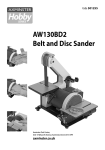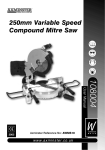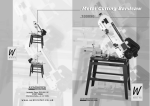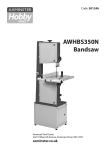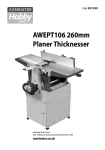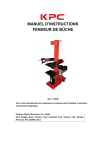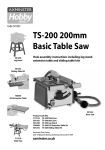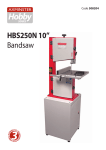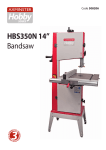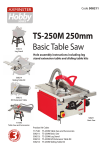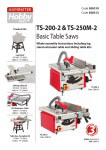Download Axminster AWSMS102 Instruction manual
Transcript
Code: 501243 AWSMS102 250mm Mitre Saw Axminster Tool Centre, Unit 10 Weycroft Avenue, Axminster, Devon EX13 5PH axminster.co.uk Index of Contents Page No. Index of Contents Declaration of Conformity What’s in the Box Specification Table of Capacities General Instructions for 230V Machines General Safety Precautions for Mitre Saws Initial Setup Identification and Parts Description Adjusting the Saw Operation of the Laser Setting the Laser Changing the Saw Blade Parts Breakdown/List Notes 02 02 03 04 05 06-07 07-08-09 10 11-12-13-14-15 15-16-17 18 19 20-21 22-23-24-25-26 27 Declaration of Conformity Copied from CE Certificate The undersigned, K. Bodenstein authorised by Jiangsu Jinfeida Power Tools Co., Ltd. Xiejia Town, Gaoyou Jiangsu 225644 P.R. China declares that this product: Model number Mitre Saw (MJ2625IIIA) manufactured by Jiangsu Jinfeida Power Tools Co. is in compliance with the following standards or standardisation documents in accordance with Council Directives EN 61029-1 :2000+A11+A12 EN 61029-2-9 : 2002 73/23/EEC Please read the Instruction Manual prior to using your new tool; as well as the operating procedures for your new tool, there are numerous hints and tips to help you to use the tool safely and to maintain its efficiency and prolong its life. Keep this Instruction Manual readily accessible for any others who may also be required to use the tool. symbols below advise that you follow the correct Warning The safety procedures when using this machine. Fully read manual and safety instructions before use 02 Ear protection should be worn Eye protection should be worn Dust mask should be worn HAZARD HAZARD Motor gets hot Class 2 Laser What’s in the Box Model Number: MJ2625IIIA 1 No: 250mm Sliding Arm Compound Mitre Saw 1 No: 250 Saw Blade (fitted) 1 No: Arbor bolt spanner 5 No: Rubber Feet 1 No: Holding Clamp Assembly 2 No: Extension/Support frames 1 No: Cut length stop 1 No: Saw Dust collection bag 1 No: Instruction Manual 1 No: Guarantee Card 03 Specification Model Product Code Rating Power Electric Brake Spindle Lock Blade Dia/Bore Bevel Angle Range Mitre Angle Range Max Mitre Cut @45˚ Max Bevel Cut @ 45˚ Max Compound Cut @ 45˚ Max Crosscut @ 0˚ Dust Extraction Outlet Weight 04 AWSMS102 501243 Hobby 1,500W Yes Yes 250mm/30mm 0 - 45° 45°-0-45° 90 x 215mm 42 x 305mm 42 x 215mm 90 x 305mm Yes 18kg Table of Capacities Always use (250mm) saw blades with a rated speed in excess of 4,500 r.p.m. The machine is supplied with a 250mm GP (40 tooth) Saw blade, with a 30mm bore for cutting TIMBER. For precision trimming e.g. fine cut finish of bead, frame, dado etc., an 80 tooth saw blade is recommended and for cutting non-ferrous metals, an 80 tooth negative rake saw blade. It is also recommended that you use a lubricant when cutting aluminium. DO NOT CUT FERROUS METAL Because of the geometry of the raising of the lower guard, the incidence of the saw at the intersection of the fence and the table, the height of the saw washers above the table and the obstruction of the saw motor body during a right mitre cut, please study the available capacities that are shown below, and the accompanying notations. The table is drafted with the first measurement being the dimension against the fence. Although the saw is capable, with the correct saw blades fitted, of cutting plastic, aluminium, P.V.C., etc, the cutting table deals exclusively with timber. Timber Size 85mm x 130mm 45mm x 130mm 85mm x 95mm 45mm x 85mm 85mm x 85mm 45mm x 120mm Mitre Angle 0˚ 0˚ L45˚ L45˚ R45˚ R45˚ Tilt Angle 0˚ 45˚ 0˚ 45˚ 0˚ 45˚ Sliding Arm 85mm x 290mm 45mm x 290mm 85mm x 210mm 45mm x 210mm 85mm x 210mm 45mm x 210mm Please note that the supplied clamp will only clamp timber up to 100mm wide. We do not recommend that any sawing operations are carried out without stuff being securely clamped to the machine. 05 General Instructions for 230V Machines Good Working Practices/Safety The following suggestions will enable you to observe good working practices, keep yourself and fellow workers safe and maintain your tools and equipment in good working order. ! WARNING!! KEEP TOOLS AND EQUIPMENT OUT OF THE REACH OF YOUNG CHILDREN General Advice If you are totally unfamiliar with the use of a power saw, please seek at least a minimum of tuition and advice from an informed, qualified source. An amateur woodworker or hobbyist just starting out is advised to undertake a short course on the use of woodworking machines run by a professional woodworker. These are often offered by your local authority, as evening classes., etc. Primary Precautions Mains Powered Tools These tools are double insulated and supplied with a 13 Amp. plug and 2 core power cable. Before using the tool inspect the cable and the plug to make sure that neither are damaged. If any damage is visible have the tool inspected/repaired by a suitably qualified person. If it is necessary to replace the plug, it is preferable to use an 'unbreakable' type that will resist damage on site. Only use a 13 Amp plug, make sure the cable clamp is tightened securely. Fuse at 13 Amp. It is also recommended that a switched power outlet is used. If extension leads are to be used, carry out the same safety checks on them, and ensure that they are correctly rated to safely supply the current that is required for your machine. Work Place/Environment Always carry the machine with the saw locked in the housed (down) position. Pre-mounting the saw on a sub frame (a suitable piece of plywood/blockboard) with sufficient margin to allow the whole to be clamped onto a stable work surface, increases the speed with which the saw can be brought into operation. However the saw is mounted, make sure that it is clamped/screwed down to a stable, flat surface before commencing operations. The machine is designed for indoor use, do not use when or where it is liable to get wet. If the machine is set up in the open, and it starts to rain (unusual though this would be in U.K.), cover it up or move to a dry place. If the machine has gotten wet; dry it off as soon as possible, with a cloth or paper towel. Do not use 230Va.c. powered machines anywhere within the site area that is flooded or puddled, and do not trail extension cables across wet areas. Keep the machine clean; it will enable you to more easily see any damage that may have occurred. Clean the painted areas of the machine with a damp soapy cloth if needs be, do not use any solvents or cleaners, as these may cause damage to any plastic parts or to the electrical components. 06 ! Make certain that you have fitted the correct saw blade for the job in hand. ! Keep the work area as uncluttered as is practical, this includes personnel as well as material. General Instructions for 230V Machines ! WARNING!! UNDER NO CIRCUMSTANCES SHOULD CHILDREN BE ALLOWED IN WORK AREAS Once the saw is mounted, carry out any setting operations, (mitre, tilt..?), and remove all tools used in the setting operations (if any) and place safely out of the way. If you are using long lengths of material arrange for extra support beyond the boundary of the machine. It is good practice to leave the machine unplugged until work is about to commence, also make sure to unplug the machine when it is not in use. Always disconnect by pulling on the plug body and not the cable. DO NOT use your hands to hold the work on the machine, use the clamp provided, and observe the old woodworkers adage of 'never putting your hands closer than one handbreadth to the cutting tool'. Do not attempt to cut or re-cut short pieces that cannot be held by the clamp. Make sure you are comfortable before you start work, balanced, not reaching etc. If the work you are carrying out is liable to generate flying grit, dust or chips, wear the appropriate safety clothing, goggles, gloves, masks etc., If the work operation appears to be excessively noisy, wear ear-defenders. -If you wear your hair in a long style, wearing a cap, safety helmet, hairnet, even a sweatband, will minimise the possibility of your hair being caught up in the rotating parts of the tool, likewise, consideration should be given to the removal of rings and wristwatches, if these are liable to be a 'snag' hazard. DO NOT work with cutting tools of any description if you are tired, your attention is wandering or you are being subjected to distraction. A deep cut, a lost fingertip or worse, is not worth it! DO NOT work with cutting tools if you are taking prescribed medicine, unless you have confirmed that this medicine will not impair your awareness or your reactions. DO NOT use the machines within the designated safety areas of flammable liquid stores or in areas where there may be volatile gases. There are very expensive, very specialised machines for working in these areas, THIS IS NOT ONE OF THEM. CHECK that saw blades are undamaged and are kept clean and sharp, this will maintain their operating performance and lessen the loading on the tool. Above all, OBSERVE…. make sure you know what is happening around you, and USE YOUR COMMON SENSE; for no matter how many precautions we list, remember your safety is ultimately your responsibility. General Safety Precautions for Mitre Saw Before using the saw read the instructions thoroughly and make sure you understand them. Carry out a visual inspection of the saw, checking for damage, or anything untoward, (Do you know who used it last? That person may be able to confirm that the saw was “fine” when last used or not, blades need sharpening/replacing etc. 07 General Safety Precautions for Mitre Saw DO NOT change blades with power connected. Always use the correct accessories; especially the correctly sized spanner on the arbor bolt, DO NOT risk damaging the saw by using incorrectly fitting accessories. If the saw does not have a specific device to lock the saw shaft, DO NOT jam/wedge the motor fan, it is better to wedge the saw blade with a piece of scrap timber. After fitting the blade, make sure that all ancillary tools used during the blade change operation have been stowed away correctly. REMEMBER THE ARBOR BOLT HAS A LEFT HAND THREAD. When fitting blades, refer to the manufacturer’s instructions concerning the maximum capabilities of the saw, i.e. cutting capacities and capabilities in various materials, observance of these guidelines, and clean, sharp saw blades ensure maximum performance and optimise the life of your saw. DO NOT overload the saw. (Try to cut too fast) CHECK that the blade is fitted correctly, i.e. check that the blade is seated properly, the arbor bolt is fastened and a manual rotation of the blade does not indicate any wobble. CHECK that the kerf slot in the saw gullet (and under) is clear. The kerf slot is fully enclosed, as a safety measure, to protect against the saw teeth protruding through table. REMEMBER to clean it regularly. If the saw gullet gets damaged it may not support the work close up to the blade and this will result in bad breakout. Replace the saw gullet as soon as possible. CHECK the basic parameters of the saw, viz:- check the blade is vertical to the turn table when the tilt indicator reads '0'; check the blade is perpendicular to the rear fence when the turn indicator reads '0'. This will give you confidence that the angles you wish to set on the saw will be correct. If either of these basic parameters is not met, refer to the specific section in the Instruction Manual that deals with “Setting up your machine”. Set the required mitre angle or tilt angle or both, then carry out a “dry” run to ensure that you will be able to complete the saw cut without any problems. Connect the power, give the machine a quick “burst” off load and in a safe position to check that everything is correct before proceeding with the work operation. Make sure that the wood is hard against the backfence before starting the saw. Always allow the saw to run up to speed before attempting to cut. Pull the saw over in a smooth continuous movement. We strongly advise that all material is clamped to the table before any sawing is carried out. When 'fine' cutting e.g. beads, architraves, framing, etc., if the material is still 'breaking out' at the rear of the cut, you may be able to minimise the damage by the addition of a thin facing board of an appropriate hardwood, clamped or screwed across the face of the fence to act as a “spelch”.(Make sure you fasten the board on both sides of the fence and cut the saw slot before any actual work is done.) When you have finished the cut, allow the saw to rise to its 'up' position, check that the lower guard has returned to cover the saw blade. Allow the blade to come to a stop before removing the workpiece. When working with timber than is bent, bowed, in wind, cupped, etc., make sure that the offending timber is placed to the machine such that the cut will not allow the timber to 'fall' to the table or fence and pinch the saw blade. 08 General Safety Precautions for Mitre Saw DO NOT allow the saw to 'stall'; if unfortunate circumstances cause the machine to stall, switch off immediately, disconnect the machine and clear the 'jam' by hand. DO NOT attempt to re-start the machine until the 'jam' is cleared. If it was a severe 'jam' that required much heaving and knocking to clear, check the basic parameters of the machine before reconnecting the supply and re-commencing operations. NOTE. By the very nature of its operation the sliding arm mitre saw does not have the front section of the blade guarded. If you do not require the added capacity of the saw in its sliding arm configuration, push the arm to its far ‘back’ position and lock the arm securely in place. Proceed as with ordinary mitre saw operations. If you require the saw to operate in its sliding arm configuration, you must ensure that the machine is mounted on a firm, stable and secure base. REMEMBER, you are not just cutting in a downward direction now, you will also be pushing the saw through the timber, exerting a front to back force as well, a working base that was stable against a down force may not be stable enough against a side force. DO NOT attempt to use the machine as if it were a radial arm saw. The correct method is to :DISCONNECT THE SAW, set the required tilt and mitre angles on the saw, reconnect. Make sure the sliding arm clamping lock is WELL undone and the sliding arm moves freely. A) pull the raised saw to its foremost position, B) place the timber onto the table tight against the fence, C) clamp the timber, D) start the saw and allow it to run up to speed, E) "pull the saw over" at the same time pulling towards you, (so the saw is kept against its stop and won’t ‘kick’ when it engages the timber). F) press the saw into the timber, starting the cut, continue pressing down until you reach the ‘pull over’ stop, G) maintaining the downward pressure, push the saw forward through the timber until the cut is completed, H) release the trigger, allow the saw to coast to a stop, allow the saw to raise to the ‘up’ position, I) unclamp the timber and remove from the table, J) check that vibration has not moved the sliding arm clamping lock, K) start again from A). Laser Radiation This machine is equipped with a Class 2 laser device. The laser must not be replaced with any other type. The emitted radiation is not harmful in anyway. You must not modify the laser unit in any way. WARNING: DO NOT look directly into the laser beam or into the opening from which the beam is emitted. NEVER allow the beam to strike reflective Power output<1mW surfaces, or be reflected into the eyes of people or animals. Even short visual contacts can cause optical damage. Class 2 Laser 09 Initial Set Up Rubber foot Lift the saw clear of the box using the two hand grips moulded into the sides of the chassis, and set on a clear flat surface, taking care not to trap or pinch the power cable under the chassis. Remove the other items from the box. Locate the five rubber feet and insert them into each of the five machined holes beneath the chassis. (See fig A) Attach the sawdust collection bag to the dust extraction duct to the rear of the operating handle. (See figs A1,B2,C3) Fig A1 Dust extraction duct Fig A Fig B2 Sawdust collecting bag Fig C3 Phillips screw Extension Arm/Cut Length Stop Locate the two ‘U’ clamps, extention arms and the cut length stop assembly. Slide the cut length stop onto the right extension arm. (See Fig D1) Introduce the two extention arms into their appropriate housings in each side of the machine, slide the ‘U’ clamp onto the rear arm immediately inside the chassis frame, push the arm forward until it engages in the second housing, secure the ‘U’ clamp and locking bolt on the arm, tight against the inside of the chassis frame (or in such a position that the arm cannot pull out of the second housing.) When you are happy that everything is correctly positioned, tighten the locknut on the ‘U’ clamp bolt. (See fig D2) Having unpacked your saw and its accessories please dispose of any unwanted packaging properly. The packaging is biodegradable. ‘U’ clamp Locking bolt Fig D1 Cut length stop holes 10 Extension arm Fig D2 Identification and Parts Description Saw arbor lock button Guard latch Laser switch Tilt preset stop Upper guard Dust bag Motor brush inspection port Hold down clamp Fence Main Saw Chassis Extension/ support frames Turntable Mitre Scale Pointer Laser 11 Identification and Parts Description Your 250mm sliding arm compound mitre saw will have been shipped to you in the ‘housed’ position, i.e. with the saw body locked down. Please take some time to identify the various parts of your machine so that you are familiar with the terminology we will use to enable you to set up and operate your machine safely and correctly. 12 Operating handle The operating handle contains the interlocked trigger switch and the laser On/Off button switch. The handle is used to pull the saw over into the work, or push the saw through the work. To allow the saw to raise to its ‘up’ position, press down on the ‘operating’ handle to ease the pressure on the ‘lock down pin’; withdraw the pin and allow the saw to raise up under the power of its tensioning spring. Lock down pin The lock down pin is a simple latching pin that can be engaged (pushed to the left) into the saw mounting frame to hold the saw body down in the ‘housed’ position or disengaged (pulled to the right) to allow the saw body to rise to the ‘up’ position. DO NOT engage the lock down pin whilst operating the saw. Trigger switch Housed in the operating handle the trigger switch has a full hand length operating lever so that the whole hand can be used to grip both the operating handle and the switch simultaneously. Laser switch The laser switch is a push button mounted in the operating handle that toggles the laser On or Off. Guard latch Within easy reach, to the left hand side of the operating handle is the thumb operated guard latch. The guard latch prevents the saw from being pulled over by locking the lower guard in position around the blade with the saw body in the ‘up’ position. Releasing the guard by thumbing the latch to the right, allows the saw to be “pulled over.” Sliding arm The sliding arm mounts the pivot housing that carries the pivot shaft body for the saw body frame and its associated components. The locking clamp for the sliding arm is mounted on top of the tilt housing. The pivot housing also contains a tilt mechanism that allows the saw body frame to be tilted over, up to and including 45 degrees left. Mitre scale This is the shaped and engraved plate riveted to the chassis in front of the turn table. It is engraved with the angular measurements and there are various pre set "click" notches to enable quick and easy setting of the standard mitre angles. The mitre scale is engraved with two ranges of angles, one range is set from 0˚ through +50˚ and the other from 0˚ through –45˚ where 0 is with the saw set square to the fence. There is an ‘easy read’ lens mounted on the side of the turntable, to enable the scaleto be more easily read. Adjustable depth stop Located on the right of the saw behind the blade, the depth stop is a caphead bolt with a lock nut, adjusting the caphead bolt sets the depth of cut. NOTE: PLEASE ADJUST THE BOLT TO THE CORRECT HEIGHT TO ENSURE THE BLADE DOES NOT COME INTO CONTACT WITH THE TABLE SEE FIG A ON PAGE 13. Identification and Parts Description Adjustable depth stop Fig A Operating handle Trigger switch 2mm Handle Lower guard Lock down pin Motor/vents Saw body frame Sliding arm locking clamp Turn table locking clamp Tilt housing Tilt preset stop Cut length stop mounting Tilt pointer Tilt scale Tilt clamping lever 13 Identification and Parts Description Turntable Mounted into a circular recess in the main saw chassis, the turntable also mounts the extrusion that contains the kerf plate (the plate with the slot that allows the saw to enter the table) The locking clamp for the turntable is mounted on the right hand side of the chassis behind the fence. The turntable can be pivoted 50 degrees right or 45 degrees left. Sliding arm locking clamp Turning the knob clockwise will drive the threaded rod through its housing to clamp against the sliding arm, clamping it in position. Ensure that the clamp is either tightened down to hold the sliding arm in a set position, or WELL LOOSENED OFF, allowing the arm to move freely. Saw arbor lock button Used during blade changing operations, depressing this button will lock the saw arbor, enabling the spanner to loosen the arbor bolt. If the lock will not engage at first, rotate the saw blade by hand until the lock button depresses fully and the saw arbor is locked. As the lock is spring biased to the unlocked position, you will need to keep the button depressed whilst you are loosening or tightening the arbor bolt. DO NOT use this lock if power is connected to the machine, or the saw is freewheeling. Tilt adjustment stops Two adjustment stops that allow calibration of the tilt action of the saw to be preset to the vertical and 45 degrees left. Upper guard Fixed guard, part of the saw body frame, covering the top part of the saw blade. Lower guard The lower guard is a ‘cup’ guard, moulded in clear plastic, that covers the lower portion of the saw blade, at the same time allowing sight of the work operation.It is pivoted on a mounting on the upper guard and operated by a lever that rotates it out of the cutting line when the saw is ‘pulled over’. Main saw chassis Aluminium casting that mounts all the other pieces of the mitre saw. It has four moulded feet that are bored to allow fixing screws or bolts to be inserted to secure the saw to a stable work surface or a ‘quick mounting’ board. There are also two recesses in the left and right of the machine behind the fence that are for fitting the holding clamp/s. Machined into the sides of the chassis are the housings to enable the extention/support frames to be fitted. Finger indents are also moulded in the sides of the chassis to provide a secure gripping position whilst carrying the saw. To the rear of the chassis on the left hand side is the housing for the sliding arm mechanism. Extension/support frames These frames are made from 12mm steel rod, and provide extended support to either side of the table, very necessary if you are cutting longer lengths of material. Cut length stop mounting A mounting that fits onto the rear arm of the extension/support frame, along which it can be slid and clamped. The cut length stop is fitted to this and has several location holes, enabling a wide range of size to be cut. When not in required ‘flip’ the stop out of the way Saw body frame 14 Mounted on the shaft of the pivot housing on the sliding arm the saw body frame carries the guards, the motor and saw blade and the operating handle. Identification and Parts Description Fence This is an aluminium casting bolted to the rear of the saw table. It has various cut-outs and shapes machined and moulded into it to allow the mitre, tilt or compound cuts to be made. To all intents and purposes it is not adjustable, except during main setup procedures. Turntable locking clamp Turning the knob clockwise will drive the threaded rod through its housing to clamp against the table, clamping the turntable in position. Ensure the clamp is always tightened before operating the saw. DO NOT over tighten. Tilt clamping lever and scale Turning this lever anti-clockwise will release the clamp mechanism allowing the saw to be tilted up to 45 degrees left. The angle is read from the scale. Turning the lever clockwise will clamp the tilt mechanism securely. Always check that the tilt clamping mechanism is tight before operating the saw. Dust extraction outlet A 38mm dust extraction outlet that allows the saw to be connected to a suitable extraction system. If dust extraction is not available, a sawdust collecting bag is supplied for ‘quick’ jobs. Motor brush caps Two screw-in plastic brush caps one on either side of the motor body that allow the brushes to be inspected or changed. Laser The laser is a class 2 device that provides a convenient visual guide for lining up the saw blade with a line marked on the timber. It is operated by an On/Off push button toggle switch mounted in the operating handle. WARNING: DO NOT look directly into the laser beam or into the opening from which the beam is emitted. NEVER allow the beam to strike reflective surfaces, or be reflected into the eyes of people or animals. Even short visual contacts can cause optical damage. Adjusting the Saw The machine has been fully and accurately set up at the factory. If, however, you are not happy that the saw is correctly set, or that it has been put out of true by an accident on site e.g. a ‘knock’ or a ‘drop’ etc., carry out the setting up procedures as follows:- ! DISCONNECT THE SAW FROM THE MAINS SUPPLY 1. Set the table to zero mitre angle. Clean the table, the back fence and the saw blade, removing all chips, shavings, dust and resin build up. Ensure the saw blade is not distorted, and the chassis is sitting on a clean flat surface. Perpendicular (Square) Adjustment Set the saw to zero mitre angle by engaging the preset “click” stop in the mitre scale and set the gauge mark to 0˚ degrees, (See fig Ea) trip the lower blade guard latch and pull the saw over to its full extent. Place an engineers square against the fence and check that the blade is perpendicular to the fence, making sure that the square is not in contact with any of the teeth. (See fig E) If adjustment is required follow the instruction on the next page. 15 Adjusting the Saw Perpendicular (Square) Adjustment Mitre Scale Pointer Fig Ea Fig E 0˚ degrees Engineers square Locate and loosen the 4 bolts that hold the fence to the chassis. Adjust as necessary until the fence is square to the blade. Tighten the bolts, recheck that the blade and the fence are still perpendicular by moving the turntable away from zero and then re-engaging the preset. If necessary continue to adjust until the setting is correct. (See figs F & Fa) 14mm Spanner Typ. 4 Bolts Fig Fa Fence Tilt Adjustment Fig F Make sure the saw body frame is set in the upright position with the heel of the tilt frame casting hard against the stop. Trip the guard latch and pull the saw over until it engages about 6 or so teeth in the kerf plate; keeping the saw in this position, place an engineers square on the table and move it into contact with the saw blade (not the teeth). Check the vertical, if the saw is out of vertical, loosen the tilt clamping lever,(See fig H) tilt the body out of the way, loosen the lock nut on the preset stop, (See fig G) adjust the stop, lock; then tilt the saw back upright against the stop and repeat the procedure; repeat until the saw blade is vertical. When the saw is vertical reset the tilt pointer to read zero on the scale.(See fig I) Loosen the tilt clamping lever and tilt the saw until the toe of the tilt frame casting is hard down on its stop. The pointer tilt scale should read 45 degrees. (See fig J) If this is not correct, carry out a similar procedure to the vertical adjustment routine, adjusting that stop until the pointer reads 45 degrees against the scale. If possible check with a bevel gauge and a protractor, or a mitre gauge if you have one. ( N.B. unless it has been damaged, the scale should be accurate, once the saw has been set vertical and the pointer re-set). 16 Adjusting the Saw Fig G Fig H Tilt preset stop Tilt clamping lever Engineers square Tilt pointer Fig I 0˚ degrees Fig J 45˚degrees Mitre Saw at 45˚ degrees 17 Operation of the Laser WARNING!! ! THIS PRODUCT IS EQUIPPED WITH A CLASS 2 LASER. DO NOT LOOK DIRECTLY INTO THE LASER BEAM Warning. Under no circumstances should you tamper with or modify the laser to try to increase its power output. The laser fitted to the AWSMS102 Sliding Mitre Saw provides a convenient visual guide for lining up the saw blade with a line marked on the timber. Power comes to the laser from the mains input via a transformer and a toggle switch mounted in the handle of the saw (See fig K). It should be noted that power is fed to the input side of the transformer for as long as the machine is connected to the mains and that the on/off switch operates only on the low voltage output from the transformer to the laser. The position of the laser can be adjusted to align the beam precisely with the saw blade. There are no serviceable parts in the laser so if a problem occurs you will need to contact Axminster Power Tool Centre Customer Services Department. 03332 406406 Setting the Laser Take a wide board with a true straight edge and mark a line across the width using an accurate square. (See fig L) Position the board up against the fence, lower the blade onto the board and line up the left hand side of the blade with the line. (See fig M) Switch on the laser and check the alignment of the laser beam with the line marked on the board. (See fig N) If the alignment is out, the laser can be adjusted as follows: Check that the laser line is a fine line, not dispersed or splayed. Adjust this by loosening the caphead screw of the holder slightly, and twist the laser to give a fine straight line; (See fig O) retighten the holding screw. Loosen the caphead bolt that secures the mounting bracket to the frame. (See fig P) Move the fitting until the laser is lined up,(this can involve a small amount of twisting) almost lined up etc. Tighten the bolt very lightly and check again. Unfortunately, even a very small movement will move the laser line appreciably. Tightening the bolt must be done with care and may require several attempts to get 'right' correctly. When all is correct remove the board and any tools you have used during the setting up procedure, reconnect the saw to the mains supply. Square 18 Fig L Pencil mark Fig M Pencil mark Laser line Fig N Setting the Laser Fig K Laser toggle switch Fig O Fig P To adjust the laser, loosen the caphead screw on the holder To adjust the mounting bracket loosen the caphead bolt 19 Changing the Saw Blade ! DISCONNECT THE SAW FROM THE MAINS SUPPLY 1. Locate the two screws as indecated holding the front of the saw guard bracket, and loosen and remove them to allow the saw guard bracket to pivot on the rear screw. (See fig Q) Swing the saw guard bracket and the guard fully out of the way, to enable access to the saw arbor bolt. (See fig R) Engage the saw arbor lock and fit a 13mm spanner onto the bolt, keeping the lock depressed, loosen the saw arbor bolt by turning clockwise, (left hand thread), (See figs S & Sa) once the bolt is free, unscrew, and remove the bolt, the washer and the outer flange. Keeping the guard out of the way, tilt the blade off the inner flange and ‘wriggle’ it out of the saw. Watch out for sharp edges/teeth etc. Note. It sometimes helps to ‘wheel’ the blade out of the guarding. Fig Q Saw guard bracket Screw 1 Saw guard Screw 2 Fig R Rear screw Arbor bolt Flange 20 Swing the saw guard bracket and the guard fully out of the way, to enable access to the saw arbor bolt. Changing the Saw Blade Fig S Fig Sa 13mm Spanner Saw arbor lock button Engage the saw arbor lock and fit the spanner onto the bolt, keeping the lock depressed, loosen the saw arbor bolt by turning clockwise, (left hand thread). 2. Before fitting the new blade ensure that the inner saw blade washer is clean and correctly seated on the shaft. Fit the blade over the shaft and check it is seated correctly against the rear saw plate washer. Locate the offside blade washer over the shaft and the ‘key’ flanging, introduce the arbor bolt and its washer, screw in until finger tight, check everything is seated correctly. Engage the arbor lock and tighten the arbor bolt (anti-clockwise). Turn the blade by hand to check that everything seems O.K.. Put the arbor bolt spanner back in its stowage. Rotate the saw guard bracket back into position (make sure the operating lever is correctly positioned) and the saw guard bracket is fully back on its holding screws, re-tighten, check everything moves freely and correctly, then tighten securely. 3. Reconnect the saw to the supply, ensure that the saw is in a safe position, the blade is free, and give the machine a quick burst to check all is O.K., i.e. the blade runs true, no vibration, etc. 21 Parts Breakdown/List 22 Identification and Parts Description 23 Identification and Parts Description 24 Identification and Parts Description 25 Identification and Parts Description 26 Notes 27 Please dispose of packaging for the product in a responsible manner. It is suitable for recycling. Help to protect the environment, take the packaging to the local recycling centre and place into the appropriate recycling bin. Only for EU countries Do not dispose of electric tools together with household waste material. In observance of European Directive 2002/96/EC on waste electrical and electronic equipment and its implementation in accordance with national law, electric tools that have reached the end of their life must be collected separately and returned to an environmentally compatible recycling facility.




























